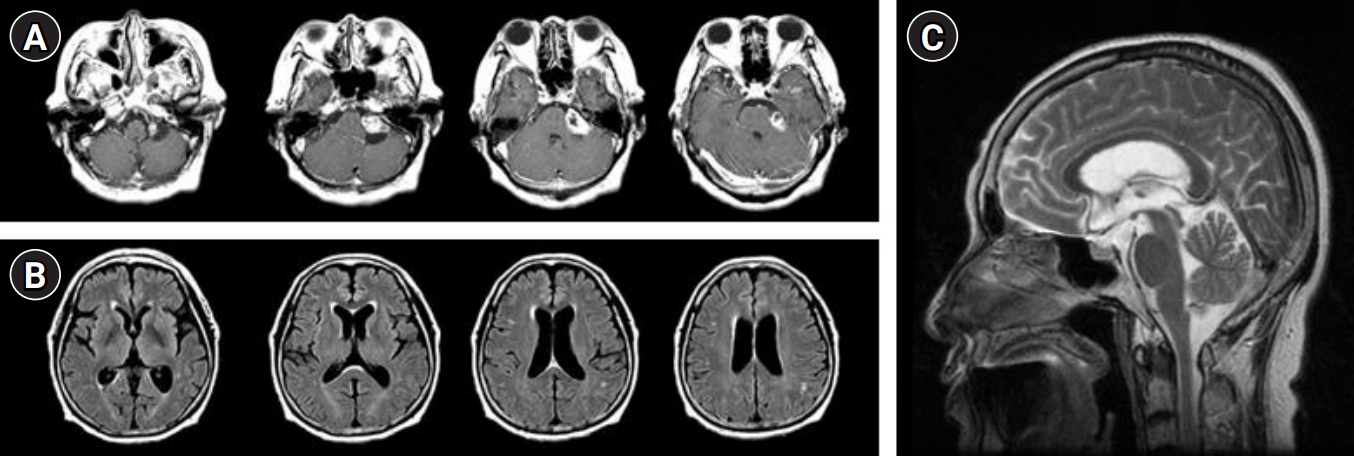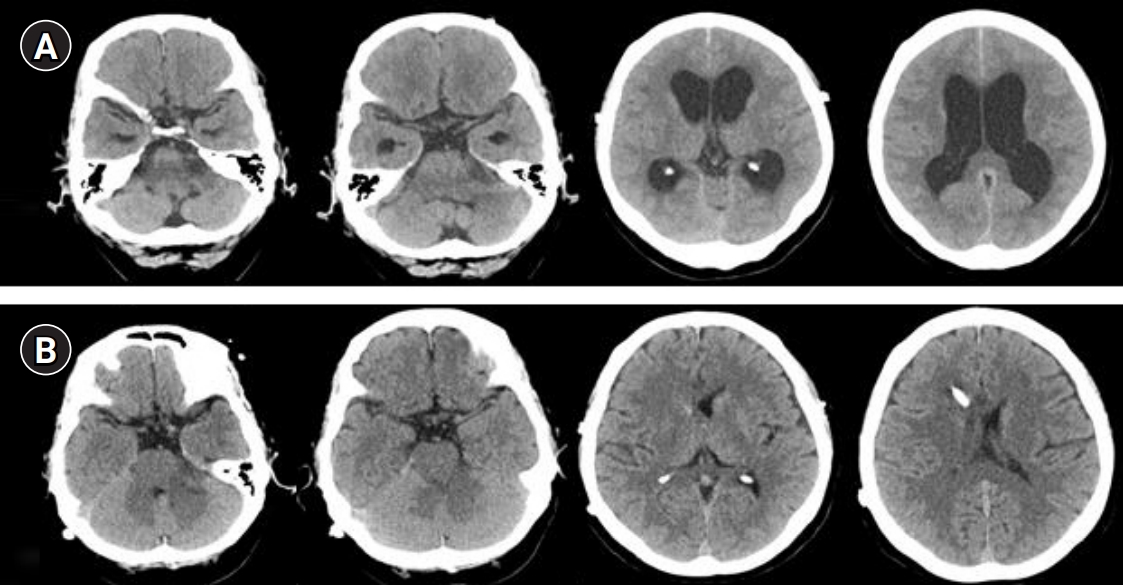AbstractBackgroundVestibular schwannoma is a benign, usually slow-growing tumor, which develops from Schwann cells of the eighth cranial nerve.
Case ReportThe treatment options for the schwannoma are surgical removal or gamma knife radiosurgery. The treatment of choice depends on the size of the tumor and the level of hearing in the affected ear. After gamma knife radiosurgery, there may be some neurological complications including headache, dizziness, motor or cranial nerve deficits, seizure, carotid artery stenosis, and increased intracranial pressure. Hydrocephalus is a rare complication of gamma knife radiosurgery for vestibular schwannoma.
INTRODUCTIONVestibular schwannoma (VS) is a benign tumor that grows in Schwann cells of the eighth cranial nerve, and it can be treated by surgical removal or stereotactic radiosurgery including gamma knife surgery. Stereotactic radiosurgery for VS was first attempted in 1969 and has been one of the most active treatments in the last 40 years. The main side effects include facial paralysis, hearing loss, trigeminal neuralgia, and hemifacial spasm [1]. In addition, hydrocephalus is a potential concomitant disease [2-4]. In this article, we report a case of normal pressure hydrocephalus (NPH) in VS that has undergone gamma knife radiosurgery.
CASE REPORTA 67-year-old woman visited the clinic with hearing loss in the left ear. The symptom began 1 month previously. She did not have a specific medical history, except for myasthenia gravis. Vital signs were within normal ranges. Rinne test was normal on both sides. However, the Weber test detected sensorineural hearing loss on the left side. No other abnormalities were observed during other neurological examinations. Magnetic resonance imaging revealed a high signal intensity mass measuring 2.7 cm├Ś3.0 cm with fine enhancement on the left cerebellopontine angle (Fig. 1). This lesion was diagnosed as VS, and gamma knife surgery was performed.
Three months after, the patient visited the clinic again, complaining of progressive cognitive decline, gait disturbance, and urinary incontinence. Neurologic examination revealed normal cranial nerve functions. Motor and sensory functions were intact. Finger-to-nose and heel-to-shin tests were normal. However, she had a magnetic gait with a wide base. Additionally, she kept on losing her balance as she walked. The Timed Up and Go test was measured at 26 seconds. The patient had 2 years of education. Her Korean Mini-Mental Status Examination (K-MMSE) score was 17/30. Moreover, Seoul Neuropsychological Screening Battery (SNSB) showed impaired attention, verbal and visual memory, and executive function (Table 1).
On follow-up computed tomography (CT) scan, the size of the VS decreased from 2.7 cm├Ś3.0 cm to 1.6 cm├Ś2.8 cm, reducing the mass effect to the surrounding brain stem. However, newly developed bilateral ventricular dilatation was observed (Fig. 2). The Evans ratio was 0.37. Cerebrospinal fluid (CSF) drainage was performed, and the pressure was measured at 10 cm H2O. Leukocyte count was 0/mm3, erythrocyte count was 0/mm3, protein concentration was 58 mg/dL, and sugar level was 88 mg/dL (blood sugar, 97 mg/dL), demonstrating mild increases in protein level. After CSF drainage, the patientŌĆÖs gait and urinary incontinence improved. The Timed Up and Go test was measured again, and the result decreased from 26 to 22 seconds. A ventriculoperitoneal shunt was inserted, resulting in subjective improvements in the gait disturbance. Her follow-up K-MMSE score improved to 22, and visual memory and executive function in the SNSB, performed after 3 months, also improved (Table 1). Another CT scan was conducted, and it revealed that the size of the ventricle had decreased, and the Evans ratio measured 0.21 (Fig. 2).
DISCUSSIONHydrocephalus has been reported repeatedly in patients with VS who undergo gamma knife radiosurgery [1-5]. A causal relationship, however, has not been identified, and the mechanism remains unclear. The most likely hypothesis for the relationship between gamma knife radiosurgery and hydrocephalus involves tumor necrosis, which causes the protein to deposit in arachnoid granulation and interfere with CSF absorption [3]. In this case, the level of protein was slightly increased, supporting this hypothesis. In addition, fourth ventricle compression [6] or CSF flow alteration in basilar cisterns [7] is considered to be another potential mechanism. However, whether these side effects occur only in radiosurgery, including gamma knife, is still controversial [8,9].
According to a 2012 study [9], 19.9% of patients who underwent gamma knife surgery were diagnosed with hydrocephalus. However, 12.8% were diagnosed before gamma knife surgery and 7.6% occurred after surgery. In the same study, there was a statistically significant risk of the development of hydrocephalus, especially in patients with large tumor masses or who are female. With this in mind, the patient in this case was diagnosed with newly developed NPH, characterized by the traditional triad of gradual memory loss, gait disturbance, and urinary incontinence 3 months after gamma knife surgery. The causal relationship between NPH and gamma knife radiosurgery is further supported by the patient's symptom recovery with the insertion of a ventricular abdominal shunt.
As mentioned above, there have been several reported cases of hydrocephalus developing after radiosurgery for VS. However, in this case, the patient complained of a sudden decline in cognitive function, gait disturbance, and urinary frequency after gamma knife surgery, and the recovery of cognitive function after the shunt operation was confirmed through subjective reports by patients and guardians, as well as objective neuropsychiatric tests. This case is meaningful in emphasizing that neurologists should actively discriminate and exclude secondary correctable causes, such as NPH, when rapid progressive cognitive decline and gait disturbances occur in patients with a history of brain radiosurgery, especially considering its reversibility.
ARTICLE INFORMATIONFig.┬Ā1.(A) T1-enhanced images show a mass in the left cerebellopontine angle. (B) Fluid-attenuated inversion recovery images reveal a normal-sized ventricle. (C) T1 midsagittal view does not show any evidence of non-communicating hydrocephalus. 
Fig.┬Ā2.Non-contrast computed tomography (CT) images of the patient. (A) Three months after gamma knife surgery, follow-up CT scans revealed enlarged ventricles. (B) After ventriculoperitoneal shunt insertion, the size of the ventricles normalized. 
Table┬Ā1.Results of the neuropsychological test (SNSB) of pre- and post-ventriculoperitoneal shunt SNSB, Seoul Neuropsychological Screening Battery; K-MMSE, Korean Mini-Mental Status Examination; K-BNT, Korean-Boston Naming Test; RCFT, Rey Complex Figure Test; NA, not applicable; SVLT, Seoul Verbal Learning Test; COWAT, Controlled Oral Word Association Test; K-CWST, Korean-Color Word Stroop Test; CDR, Clinical Dementia Rating; GDS, Global deterioration scale; B-ADL, Basic Activity of Daily Living. REFERENCES1. Hasegawa T, Kida Y, Kato T, Iizuka H, Kuramitsu S, Yamamoto T. Long-term safety and efficacy of stereotactic radiosurgery for vestibular schwannomas: evaluation of 440 patients more than 10 years after treatment with Gamma Knife surgery. J Neurosurg 2013;118:557-65.
2. Cauley KA, Ratkovits B, Braff SP, Linnell G. Communicating hydrocephalus after gamma knife radiosurgery for vestibular schwannoma: an MR imaging study. AJNR Am J Neuroradiol 2009;30:992-4.
3. Bloch J, Vernet O, Aub├® M, Villemure JG. Non-obstructive hydrocephalus associated with intracranial schwannomas: hyperproteinorrhachia as an etiopathological factor? Acta Neurochir (Wien) 2003;145:73-8.
4. Rogg JM, Ahn SH, Tung GA, Reinert SE, Nor├®n G. Prevalence of hydrocephalus in 157 patients with vestibular schwannoma. Neuroradiology 2005;47:344-51.
5. Nor├®n G. Long-term complications following gamma knife radiosurgery of vestibular schwannomas. Stereotact Funct Neurosurg 1998;70 Suppl 1:65-73.
6. Briggs RJ, Shelton C, Kwartler JA, Hitselberger W. Management of hydrocephalus resulting from acoustic neuromas. Otolaryngol Head Neck Surg 1993;109:1020-4.
7. Steenerson RL, Payne N. Hydrocephalus in the patient with acoustic neuroma. Otolaryngol Head Neck Surg 1992;107:35-9.
|
|
||||||||||||||||||||||||||||||||||||